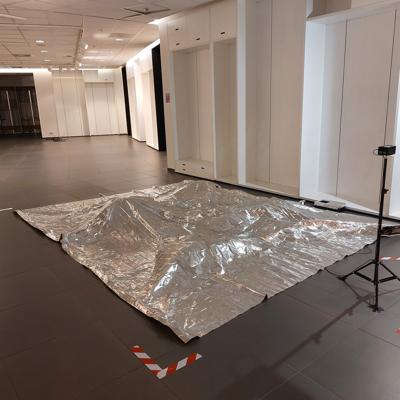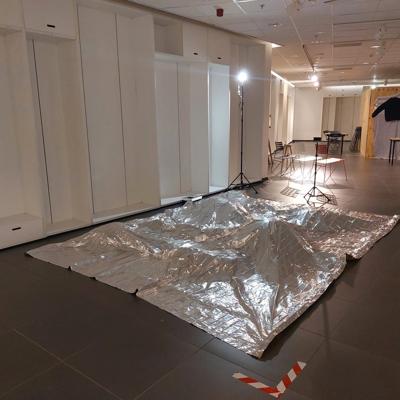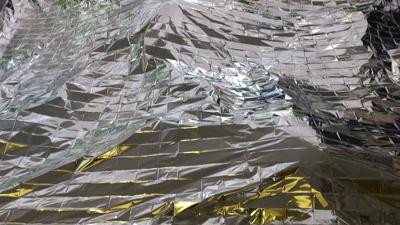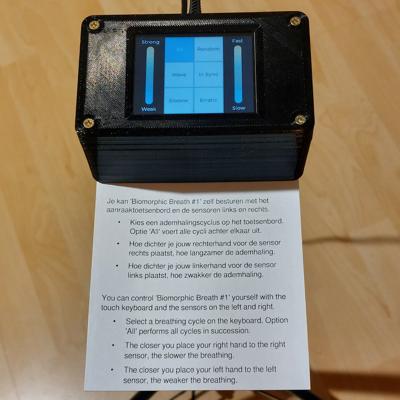Introduction
Biomorphic Breath #1 is a kinetic installation that breathes new life into discarded computer parts.
The work measures 3 by 4 meters and consists of a silver foil laid out on the ground. This foil moves up and down in an organic way, following a shifting, ‘breathing’ pattern. The viewer can influence the installation by adjusting the pattern, speed, and intensity.
Biomorphic Breath #1 playfully demonstrates that with some creativity, raw materials and components deserve a second life.
The name “Biomorphic Breath #1” is inspired by the association with breathing. The sequence number #1 suggests that more similar works can be expected.
Behavior
The installation sometimes behaves hectic, next almost unnoticeable, suddenly disturbingly irregular. The movement patterns change over time automatically.
The audience can interact with the installation by choosing different breathing patterns with the remote control. They can also influence the speed and intensity of the movements by activating the sensors on each side of the remote control with their hands.
- Select a breathing cycle on the keyboard. Option 'All' performs all cycles in succession. Selecting a specific cycle with an appropriate name is an option as well.
- The closer you place your right hand to the right sensor, the slower the 'breathing'.
- The closer you place your left hand to the left sensor, the weaker the 'breathing'.
Mindset and Philosophy
- Reuse and up-cycle
- The kinetic installation is partly made from e-waste and cheap household items that are transformed into an engaging audience experience. I contacted the local waste management company and a computer store and asked for old computer power supplies and cooling fans, which they happily supplied.
- Flexible and modular
- The bags with back to back fans are a cheap way to do lightweight movements of fabrics, foils, paper, etc. that can be combined in several ways.
- Low-cost
- I am using abandoned fans sourced from unused processor coolers, an old desktop power supply, cheap household items, throwaway items, standard UTP-cabling, cheap microcontrollers.
- Lightweight
- The installation is light and compact to transport, minimizing transport and setup costs.
- Open source
- I plan to document and share this project to enable other artists to use this concept for their own goals.
Technical Details
- Eight 60 liter trash bags are laying on the ground in a grid pattern.
- Each trash bag has two fans mounted in opposite directions. The fans are placed in a tube made from PET bottles. This setup makes it possible to inflate and deflate the bags under software control. The fans are from abandoned CPU-coolers. Rubber bandages keep the bags in place.
- The CPU-cooler fans are controlled with Pulse Width Modulation. The PWM-signals are controlled with a microcontroller programmed in C++. I used the Arduino environment to keep the technical barrier low for less technical builders who like to implement a similar system.
- The microcontroller is connected with 16 fans in total to control the inflate-deflate cycle of each bag individually. Different predetermined sequences or randomly generated sequences are implemented. The duration and intensity of the inflate-deflate cycles are controlled within certain limits.
- On top of the bags are four connected Mylar emergency foil blankets, each measuring 160 cm by 210 cm. The foils are pushed up and down by the inflate-deflate cycles of the trash bags. The maximum height is about 50 cm.
- The whole construction is fixed with a construction of recycled tent poles.
- The remote has a touch screen and two ultrasonic sensors allowing the audience to interact with the installation:
- Selecting different programmed inflate-deflate sequences.
- Select a random sequence.
- Change the intensity of the inflation-deflation sequences by moving one hand in front of an ultrasonic sensor.
- Change the pace of the inflation-deflation sequences by moving another hand in front of the second ultrasonic transducer.
Material list
- 16 recycled CPU cooler fans.
- 8 plastic trash bags made from recycled materials.
- 6 PET beverage bottles.
- Galvanized wire mesh to protect fans and people.
- 4 Mylar sheets, also known as space blankets or emergency blankets.
- A frame build from tent poles from old tents to fix the Mylar sheets.
- 1 recycled computer power supply.
- 2 Espressif ESP32-WROOM-32 microcontrollers.
- 1 ESP32-2432S028R, a.k.a. the Cheap Yellow Display.
- UTP network cables providing power and signal interconnections.
- Prototyping printed circuit boards.
- Electric components like resistors, BS170 fets, condensators, diodes, etc.
- Solder.
- Electric wire.
- Several electric interconnection materials.
- RJ45 connectors.
- Tape.
- Elastic bands.
- An old shoebox.
- 2 photography lamp stand tripods.
- 1 LED lamp 30 watt.
- 3D-printed enclosure.
- USB cable.
- 2 HC-SR04 ultrasonic sensors.
- USB power supply.




